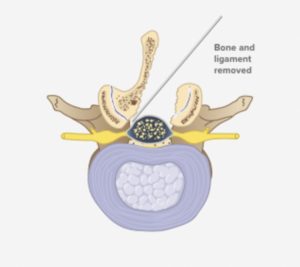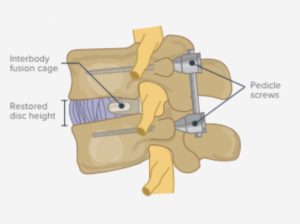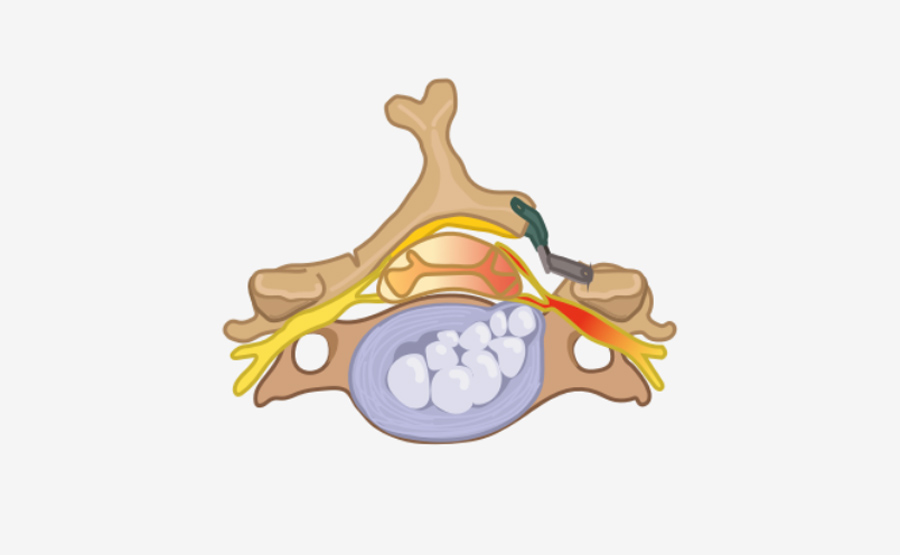If other non-surgical treatments haven’t reduced your symptoms, your doctor could recommend surgical treatment. Surgery can relieve pressure on your spinal cord and stabilize parts of your spinal segment that may be causing pain. Depending on the condition, location, and severity of your symptoms, your doctor may recommend different types of surgery. Some of the common surgeries include:
Spinal Decompression (Laminectomy)
 The lamina is a part of your spine that makes up the posterior (furthest back in position) wall. It is adjacent to the spinal canal, and therefore it can be a part of the reason why you are experiencing spinal stenosis. A laminectomy is a procedure that eases pressure on the spinal nerves by removing the back part of the vertebrae (lamina). To maintain strength in your spine, your doctor may also link the affected vertebra to another one with metal hardware in a process called spinal fusion. Because a laminectomy creates more space around the spinal nerves, they are no longer being crowded and pinched. This leads to a reduction in the pain associated with spinal stenosis. This is also known as a spinal decompression surgery as it reduces pressure in your spine.
The lamina is a part of your spine that makes up the posterior (furthest back in position) wall. It is adjacent to the spinal canal, and therefore it can be a part of the reason why you are experiencing spinal stenosis. A laminectomy is a procedure that eases pressure on the spinal nerves by removing the back part of the vertebrae (lamina). To maintain strength in your spine, your doctor may also link the affected vertebra to another one with metal hardware in a process called spinal fusion. Because a laminectomy creates more space around the spinal nerves, they are no longer being crowded and pinched. This leads to a reduction in the pain associated with spinal stenosis. This is also known as a spinal decompression surgery as it reduces pressure in your spine.
Spinal Fusion
A spinal fusion joins together two or more of your vertebrae to stabilize the spine, by using bone grafts and hardware (screws, plates, etc). The bone grafts are placed across the vertebrae after a laminectomy. Over the course of three to six months, with the help of the hardware, the bone graft will develop into one piece of bone.
Laminotomy
A laminotomy is similar to a laminectomy, but your doctor will remove only a portion of lamina (back of the vertebrae). Usually, your doctor will create a hole just big enough to relieve pressure in a particular spot. It can be performed in the lumbar (lower back) or cervical (neck) spine.
Laminoplasty
 A laminoplasty is a surgery that enlarges the spinal canal. This procedure is typically done in the cervical (neck) spine. To open up space, your doctor will create a hinge on one side of the lamina. Because the lamina is adjacent to the spinal canal, and it can be a part of the reason why you are experiencing spinal stenosis. A laminoplasty allows your nerves to have more space in the spinal canal, effectively reducing the pain felt when nerves are crowded or pinched in stenosis. A laminoplasty is only performed when your spine is affected by stenosis in multiple places as it has less negative effects on stability than a laminectomy.
A laminoplasty is a surgery that enlarges the spinal canal. This procedure is typically done in the cervical (neck) spine. To open up space, your doctor will create a hinge on one side of the lamina. Because the lamina is adjacent to the spinal canal, and it can be a part of the reason why you are experiencing spinal stenosis. A laminoplasty allows your nerves to have more space in the spinal canal, effectively reducing the pain felt when nerves are crowded or pinched in stenosis. A laminoplasty is only performed when your spine is affected by stenosis in multiple places as it has less negative effects on stability than a laminectomy.
Disclaimer – All information is for educational pursuit and information purposes only. It is not intended nor implied to be a substitute for professional medical advice. The viewer should always consult his or her healthcare provider to determine the appropriateness of the information for their own situation or if they have any questions regarding their medical condition, diagnosis, procedures, treatment plan, or other health related topics.

